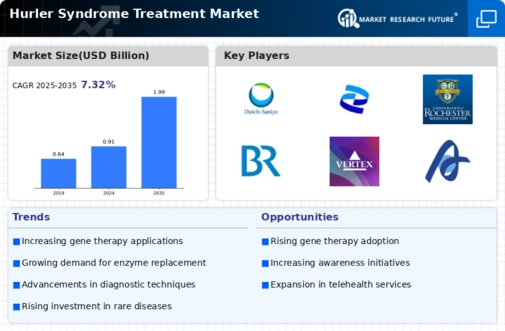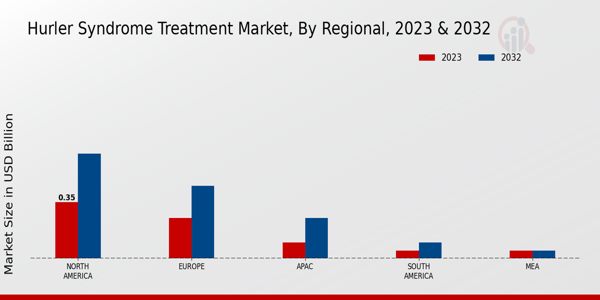Market Growth Projections
The Global Hurler Syndrome Treatment Market Industry is projected to experience substantial growth over the next decade. With a market value anticipated to reach 0.91 USD Billion in 2024 and potentially 1.99 USD Billion by 2035, the industry is poised for a robust expansion. The compound annual growth rate (CAGR) of 7.35% from 2025 to 2035 indicates a strong upward trend, driven by factors such as increasing prevalence, advancements in treatment options, and heightened awareness. This growth trajectory reflects the ongoing commitment to improving patient outcomes and addressing the unmet needs within the realm of Hurler Syndrome treatment.
Advancements in Gene Therapy
Recent advancements in gene therapy are poised to revolutionize the Global Hurler Syndrome Treatment Market Industry. Innovative therapies targeting the underlying genetic causes of Hurler Syndrome are emerging, offering hope for more effective and long-lasting treatments. For instance, enzyme replacement therapy has shown promise in improving patient outcomes. The introduction of these novel therapies is likely to enhance the overall treatment landscape, attracting investment and research efforts. As the market evolves, the anticipated compound annual growth rate (CAGR) of 7.35% from 2025 to 2035 underscores the potential for significant growth driven by these advancements.
Rising Awareness and Education
Rising awareness and education regarding Hurler Syndrome are significantly influencing the Global Hurler Syndrome Treatment Market Industry. Increased efforts by advocacy groups and healthcare professionals to educate the public about this rare disorder are leading to earlier diagnosis and treatment. Campaigns aimed at healthcare providers and families are crucial in disseminating information about symptoms and available therapies. This heightened awareness is likely to result in a larger patient population seeking treatment, thereby expanding the market. As more individuals are diagnosed and treated, the demand for effective therapies will continue to grow, further propelling market dynamics.
Government Initiatives and Funding
Government initiatives and funding play a crucial role in shaping the Global Hurler Syndrome Treatment Market Industry. Various health organizations and government bodies are increasingly recognizing the need for research and development in rare diseases, including Hurler Syndrome. Funding programs aimed at supporting clinical trials and innovative treatment approaches are becoming more prevalent. For example, the National Institutes of Health has allocated resources to investigate new therapies for rare genetic disorders. Such initiatives not only foster innovation but also enhance patient access to cutting-edge treatments, thereby stimulating market growth and improving health outcomes for affected individuals.
Increasing Prevalence of Hurler Syndrome
The Global Hurler Syndrome Treatment Market Industry is experiencing growth due to the rising prevalence of Hurler Syndrome, a rare genetic disorder. Current estimates suggest that the incidence of this condition is approximately 1 in 100,000 live births. As awareness increases, more cases are being diagnosed, leading to a greater demand for effective treatment options. This trend is expected to contribute to the market's expansion, with projections indicating a market value of 0.91 USD Billion in 2024, potentially reaching 1.99 USD Billion by 2035. The growing patient population necessitates advancements in treatment modalities, thereby driving market growth.
Collaborations and Partnerships in Research
Collaborations and partnerships among pharmaceutical companies, research institutions, and healthcare providers are becoming increasingly prevalent in the Global Hurler Syndrome Treatment Market Industry. These alliances facilitate the sharing of knowledge, resources, and expertise, accelerating the development of new therapies. For instance, joint ventures focused on clinical trials for innovative treatments are emerging, enhancing the likelihood of successful outcomes. Such collaborations not only streamline the research process but also enhance the overall efficiency of bringing new therapies to market. As these partnerships flourish, they are expected to contribute to the market's growth trajectory, fostering innovation and improving treatment options.
















